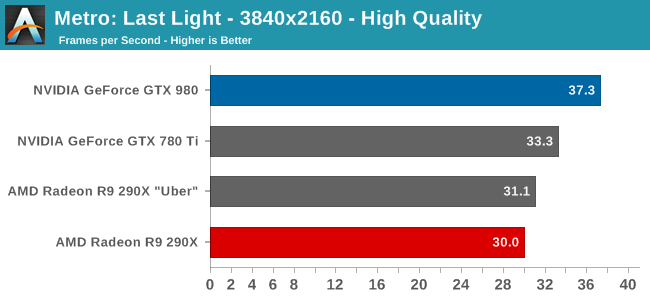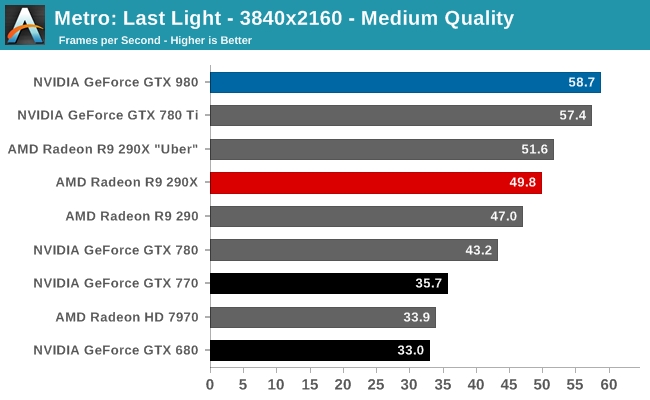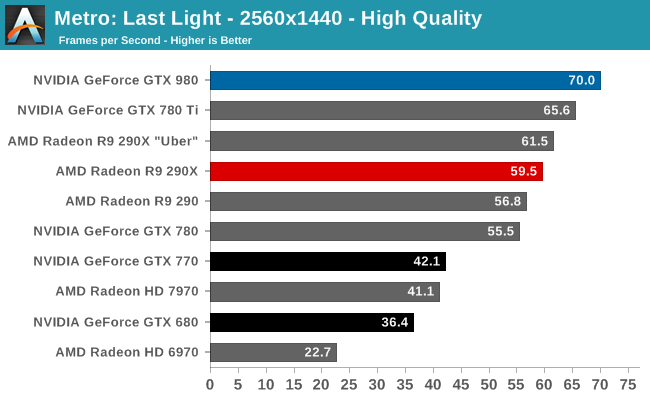The NVIDIA GeForce GTX 980 Review: Maxwell Mark 2
by Ryan Smith on September 18, 2014 10:30 PM ESTMetro: Last Light
As always, kicking off our look at performance is 4A Games’ latest entry in their Metro series of subterranean shooters, Metro: Last Light. The original Metro: 2033 was a graphically punishing game for its time and Metro: Last Light is in its own right too. On the other hand it scales well with resolution and quality settings, so it’s still playable on lower end hardware.




As has become customary for us for the last couple of high-end video card reviews, we’re going to be running all of our 4K video card benchmarks at both high quality and at a lower quality level. In practice not even GTX 980 is going to be fast enough to comfortably play most of these games at 3840x2160 with everything cranked up – that is going to be multi-GPU territory – so for that reason we’re including a lower quality setting to showcase just what performance looks like at settings more realistic for a single GPU.
GTX 980 comes out swinging in our first set of benchmarks. If there was any doubt that it could surpass the likes of R9 290XU and GTX 780 Ti, then this first benchmark is a great place to set those doubts to rest. At all resolutions and quality settings it comes out on top, surpassing NVIDIA’s former consumer flagship by anywhere from a few percent to 12% at 4K with high quality settings. Otherwise against the R9 290XU it’s a consistent 13% lead at 2560 and 4K Medium.
In absolute terms this is enough performance to keep its average framerates well over 60fps at 2560, and even at 3840 Medium it comes just short of crossing the 60fps mark. High quality mode will take the wind out of GTX 980’s sails though, pushing framerates back into the borderline 30fps range.
Looking at NVIDIA’s last-generation parts for a moment, the performance gains over the lower tier GK110 based GTX 780 are around 25-35%. This is about where you’d expect to see a new GTX x80 card given NVIDIA’s quasi-regular 2 year performance upgrade cadence. And when extended out to a full 2 years, the performance advantage over GTX 680 is anywhere between 60% and 92% depending on the resolution we’re looking at. NVIDIA proclaims that GTX 980 will achieve 2x the performance per watt of GTX 680, and since GTX 980 is designed to operate at a lower TDP than GTX 680, as we can see it means performance over GTX 680 won’t quite be doubled in most cases.










274 Comments
View All Comments
rennya - Friday, September 19, 2014 - link
Any info what HDMI 2.0 level and HDCP version this nVidia GPU has? It can only be between these ywo; HDMI 2.0 level B HDCP 2.2 or HDMI 2.0 level A HDCP 2.0.If it was the former, gaming performance in 4K displays that use HDMI 2.0. If it was the latter, this card is DOA when Bluray 4K videos comes out.
khanov - Friday, September 19, 2014 - link
Ideally, we consumers want a full HDMI 2.0 spec transceiver with 20+Gbps bandwidth AND HDCP 2.2. But these are not yet available and that is why we see these stop-gap measures that manufacturers are calling HDMI 2.0 A and B. This should *hopefully* be resolved by next year.In the meantime, I'd also like to know what exactly Nvidia is offering in the 970 and 980 cards. Without HDCP 2.2 the compatibility of these cards with future TV and AV gear is questionable.
Ryan, are you able to clarify please?
Ryan Smith - Saturday, September 20, 2014 - link
I don't have any more information available. But I will look into it.AnnonymousCoward - Friday, September 26, 2014 - link
If the stupid TV industry had went with the existing and mature DisplayPort interface for 4K, we wouldn't have these stupid HDMI 2.0 problems.warisz00r - Thursday, September 18, 2014 - link
So is it viable to drop a 970 or 980 in a sub-600W setup?dishayu - Thursday, September 18, 2014 - link
The whole system peaks at 300W. Even a cheap, non 80+ certified 500W power supply should be able to deliver that much with complete safety.Alexvrb - Saturday, September 20, 2014 - link
I would NEVER buy a PSU that isn't at least a somewhat halfway decent 80+ certified unit. Especially if you're going to then combine it with expensive components. At this point anything that falls under the category of "Cheap non 80+" is as likely to explode and catch fire as it is to run with complete safety. :P$30 gets you a 500W 80+ certified unit anyway.
nandnandnand - Thursday, September 18, 2014 - link
"GM204 ends up weighing in at 5.2 billion transistors, with a die size of 398mm2. This compares to 3.54B transistors and a die size of 294mm2 for GK104, and 7.1B transistors for 551mm2 for GK110."Does this mean there will be a 10 billion transistor GM210
extide - Friday, September 19, 2014 - link
Probably, yes, but not @ 28nm ;)Laststop311 - Friday, September 19, 2014 - link
I think you are right. Unless there is another huge delay big maxwell will not see the light of day till 20nm. At 28nm the die size would be astronomical and thats too expensive.